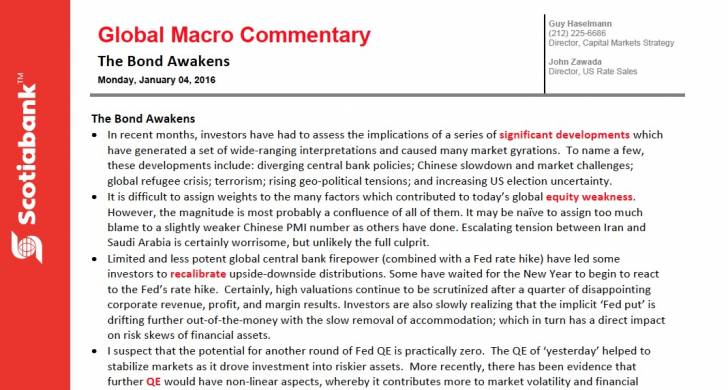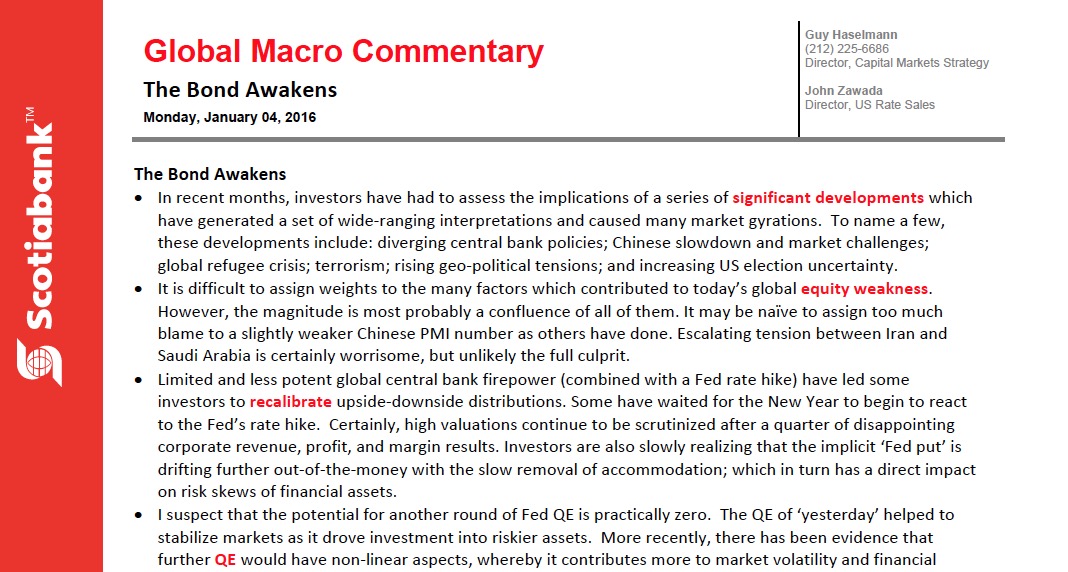The Bond Awakens
 by Guy Haselmann, Director, Capital Markets Strategy, Scotiabank GBM
by Guy Haselmann, Director, Capital Markets Strategy, Scotiabank GBM
· In recent months, investors have had to assess the implications of a series of significant developments which have generated a set of wide-ranging interpretations and caused many market gyrations. To name a few, these developments include: diverging central bank policies; Chinese slowdown and market challenges; global refugee crisis; terrorism; rising geo-political tensions; and increasing US election uncertainty.
· It is difficult to assign weights to the many factors which contributed to today’s global equity weakness. However, the magnitude is most probably a confluence of all of them. It may be naïve to assign too much blame to a slightly weaker Chinese PMI number as others have done. Escalating tension between Iran and Saudi Arabia is certainly worrisome, but unlikely the full culprit.
· Limited and less potent global central bank firepower (combined with a Fed rate hike) have led some investors to recalibrate upside-downside distributions. Some have waited for the New Year to begin to react to the Fed’s rate hike. Certainly, high valuations continue to be scrutinized after a quarter of disappointing corporate revenue, profit, and margin results. Investors are also slowly realizing that the implicit ‘Fed put’ is drifting further out-of-the-money with the slow removal of accommodation; which in turn has a direct impact on risk skews of financial assets.
· I suspect that the potential for another round of Fed QE is practically zero. The QE of ‘yesterday’ helped to stabilize markets as it drove investment into riskier assets. More recently, there has been evidence that further QE would have non-linear aspects, whereby it contributes more to market volatility and financial stress than to economic benefits. There is little doubt that QE helped asset holders and those with access to cheap credit, however the negative ramifications on pensions and savers, and on widening inequality and intensifying social repugnance, have yet to be fully measured.
· There still remain strong arguments for owning long-dated Treasuries. The reasons are fundamental, technical, Pension-related, relative, fiscal, regulatory, and due to the Fed’s balance sheet management.
• Fundamental – Economists frequently forecast 10-year Treasury yields by adding expectations for growth and inflation rates to a risk premium. This formula has been unreliable in recent years. Poor understanding of factors such as globalization, innovation, indebtedness, and demographics has led to chronic over-estimations. The business cycle might now be turning lower just as the Fed is hiking.
• Technical – The Fed owns around 40% of all Treasuries 10 years and longer. The ECB is buying 2X the amount of net issuance. The BoJ remains in full QE mode. There might be a shortage of long dated high-quality collateral.
• Pension Demand - Moreover, since 2008, the Pension Benefit Guarantee Corporation has doubled its ‘per participant premium’ and tripled its ‘per unfunded vested benefits (UVB) premium’. These premiums rise on January 1st every year through 2019 and are scheduled to rise by another 25% and 30% respectively. The UVB motivation is to encourage Liability Driven Investment (LDI). The potential demand by the $3.2 trillion in corporate DB plans could be massive and have a profound impact on long Treasury securities.
• Relative – The US 10-year yields more than Germany (164 bps), France (128), Italy(67), Spain (50), Norway (85), and Japan (197). It yields 60 bps more than Slovenia and has the same yield as Bulgaria. In a highly globalized world, sovereign yield differentials among developed world economies may be more limited than in the past. A strengthening USD also increases its relative attraction.
• Fiscal – The US fiscal deficit has fallen dramatically. Net coupon issuance is expected to fall around 25% to the lowest level since 2008. Without any debt ceiling limits to worry about and due to money market reform needs, the Treasury will be funding a larger amount of its budget deficit with Bills (whose issuance as a percentage of outstanding debt is at the lowest level in almost 20 years).
• Regulatory – New capital rules (i.e., LCR) have incentivized banks to move toward more liquid securities with limited credit risk components.
• Balance Sheet – The Fed has approximately $215 billion of Treasury securities that mature in 2016 which it will be reinvesting across the coupon curve at auctions. This amount will be the equivalence of 10% to 15% of the entire gross new issuance of Treasuries in 2016.
· On a final note, 10-year Treasuries ended 2014 at 2.17% yield. At the time, most forecasted 10’s to rise to 2.75% to 3.5%. However, by the end of January yields had fallen to 1.64%. Too many pundits believe bonds are currently in a bubble, but for the reasons mentioned above, there might not actually be enough of them to go around. It is possible that Treasury bonds are not the ‘frothy’ securities. Investors should be cautious to not underestimate just how far long-maturity yields can fall.
“You must unlearn what you have learned” – Yoda
Regards,
Guy
Guy Haselmann | Capital Markets Strategy
▬▬▬▬▬▬▬▬▬▬▬▬▬▬▬▬▬▬▬▬▬▬▬▬▬▬▬
Scotiabank | Global Banking and Markets
250 Vesey Street | New York, NY 10281
T-212.225.6686 | C-917-325-5816
guy.haselmann[at]scotiabank.com
Read/Download the complete report below:
Global Macro Commentary Januray 4 - The Bond Awakens
Copyright © Scotiabank GBM
Scotiabank is a business name used by The Bank of Nova Scotia














